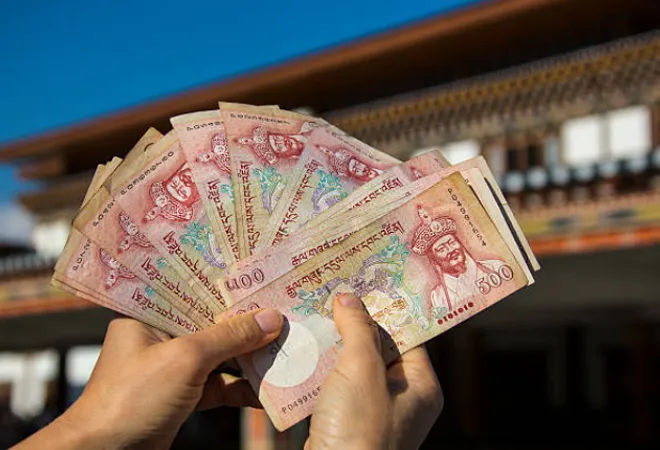
The economy of the Himalayan kingdom of Bhutan has been facing severe economic challenges due to the COVID-19 pandemic. As
elaborated by the Asian Development Bank (ADB), the government’s uncompromising and stringent containment policies and two-pronged nationwide lockdowns have impacted the supply chains, disrupted the tourism sector, and resulted in an exodus of expatriate workers, leading to a shortage of skilled and unskilled labourers. This void brought about a standstill in infrastructural projects, thereby, severely affecting the livelihood of the common people.
India’s import to Bhutan has been estimated at 77.1 percent of Bhutan’s total import value and 90.2 percent is being imported from Bhutan to India.
The country started
witnessing a fall in GDP right from 2020, when it dropped to Nu 171.51 billion from 178.56 billion, from the previous year. Additionally, it hit an all-time low in GDP growth rate in 2020, at –10.08 percent, as well. However, analysts have been forecasting rays of hope for Bhutan in 2022, with a
growth in GDP by 3.7 percent by 2022, amidst an
overall growth for the South Asia Region (SAR) estimated at 7.6 percent, as the pandemic-related economic disruptions begin to ease with time. Nonetheless, for Bhutan, given its size and geographical position, the task of revival seems to be a strenuous and cumbersome one.
The vulnerabilities
It has often been argued that the primary reason behind the country’s susceptibility towards a frail economic condition is its continued
reliance on only two major sectors—hydropower and tourism. Such a framework has been making the economic structure vulnerable to sectorial and external shocks since GDP, exports, and government revenues are mostly accumulated from these two sectors. It must be mentioned at this juncture that hydropower is mainly associated with energy intensive industries, therefore, not necessarily creating sufficient jobs. Furthermore, with the pandemic, tourism has also taken a backseat resulting in poor economic returns.
Again, Bhutan’s reliance on only one major trading partner—India—has been leading to spill-over effects from inflation, recession or political instability in the neighboring country. India shares the
rapport of being Bhutan’s largest trading partner with 9,489 crores trade valuation in 2020, which is around 82.6 percent of Bhutan’s total trade. Similarly, India’s import to Bhutan has been estimated at 77.1 percent of Bhutan’s total import value and 90.2 percent is being imported from Bhutan to India. As Bhutan has primarily put all the eggs in one major basket, the consequences that it faces are severe. Even in January 2022, community transmission of the Omicron variant of COVID -19 in the commercial capital of Bhutan—Phuentsholing—brought about a seven-day lockdown, complicating trade dynamics with India. On the Indian side is the Alipurduar district of West Bengal and Jaigaon as the border check point. Usually, there are 600 to 700 trucks that pass over to each side every day along with the easy movement of people, but that has been stalled in the recent past, thereby, affecting commerce.
In 2022, there is a chance of this inflation easing down to 5.3 percent in 2022 as prices might lower in India and the Bhutanese domestic trade improves as far as movement of vehicles is concerned.
Eventually, the
forecast of the economy rebounding back moderately in 2022 has been doing the rounds; this can be achieved only by undertaking strong policy measures like conducting vaccination drives, restoring mobility, investment spending, and reviving the tourism industry. However, inflation is expected to remain quite high for food and transportation, which are the few basic necessities of life. It rose as expected from 3.0 percent in Financial Year 2020 to 6.4 percent in Financial Year 2021. However, in 2022, there is a chance of this inflation easing down to 5.3 percent in 2022 as prices might lower in India and the Bhutanese domestic trade improves as far as movement of vehicles is concerned.
The ADB Officer-in -Charge for Bhutan, Atsushi Kaneko, has clearly stated that, “Risks to the growth outlook tilt to the downside, particularly slower than expected revival in tourism; renewed virus outbreaks with new variants; weaker than expected recovery in India; financial stress caused by a worsening nonperforming loan ratio; and, most critically, slow implementation of government investment projects” will keep the country in a tumultuous state.
To better the situation, solutions like resolving nonperforming loans (NPL) to bring about financial stability is very crucial. This will make granting loans to financial institutions more autonomous with improved credit. Moreover, other major sectors of economic potential shall also be identified with multi-stakeholder engagement and a proper plan of action. At the same time,
there must be economic diversification as well in the country with efficient allocation of power. This refers to a federal structure between the government, the private organisations, and the development partners, making the process seamless. Even though the royal government has been liberal with the incentive schemes, performance indicators for success and failures have to be laid out for each project so that Bhutan can also
move out of its Least Developed Country Index, as stipulated by the United Nations. Time is ripe to bring about this coordination so that Bhutan can live up to the economic growth estimations of 2022.
The views expressed above belong to the author(s). ORF research and analyses now available on Telegram! Click here to access our curated content — blogs, longforms and interviews.



 The economy of the Himalayan kingdom of Bhutan has been facing severe economic challenges due to the COVID-19 pandemic. As
The economy of the Himalayan kingdom of Bhutan has been facing severe economic challenges due to the COVID-19 pandemic. As  PREV
PREV


